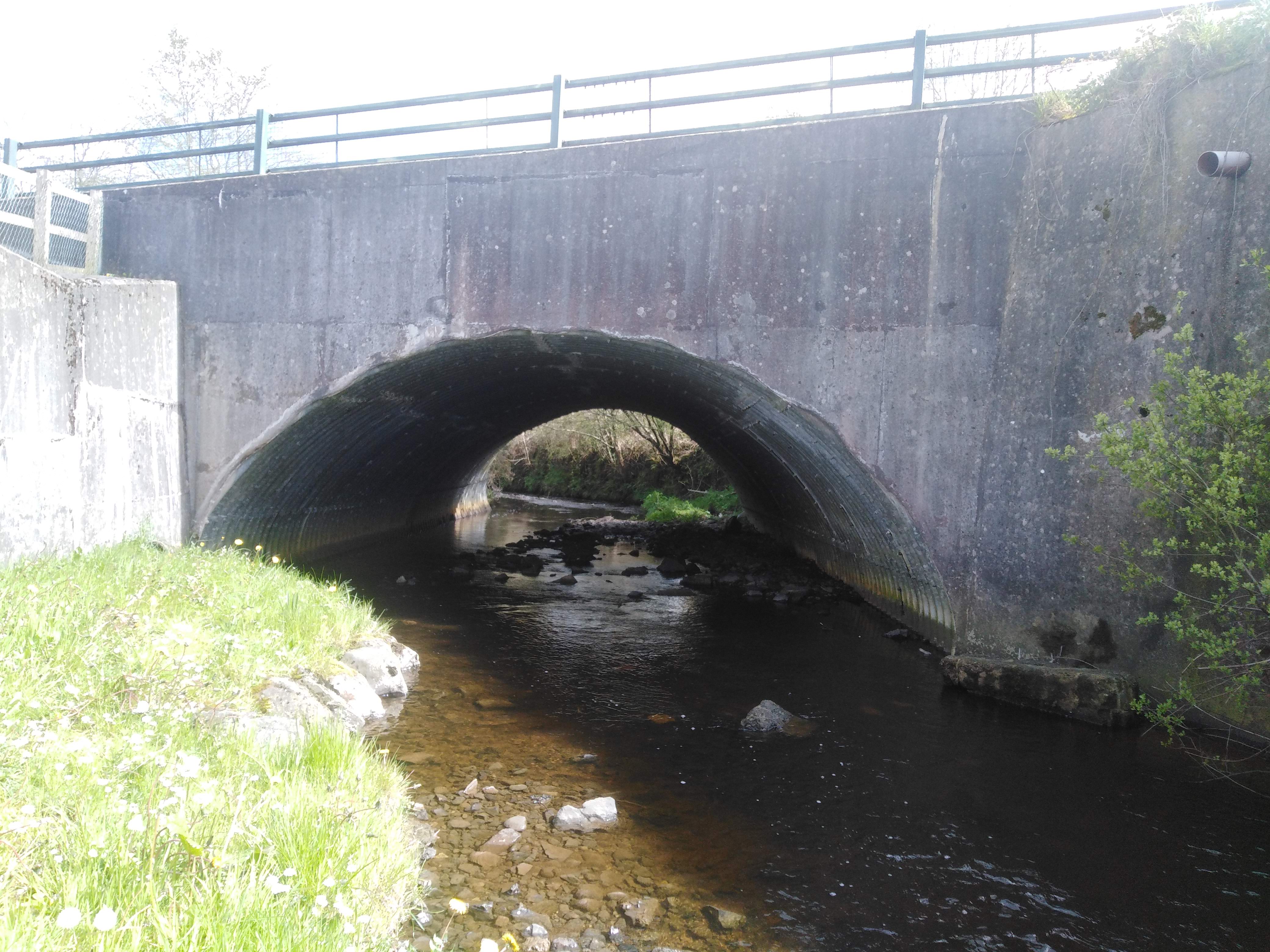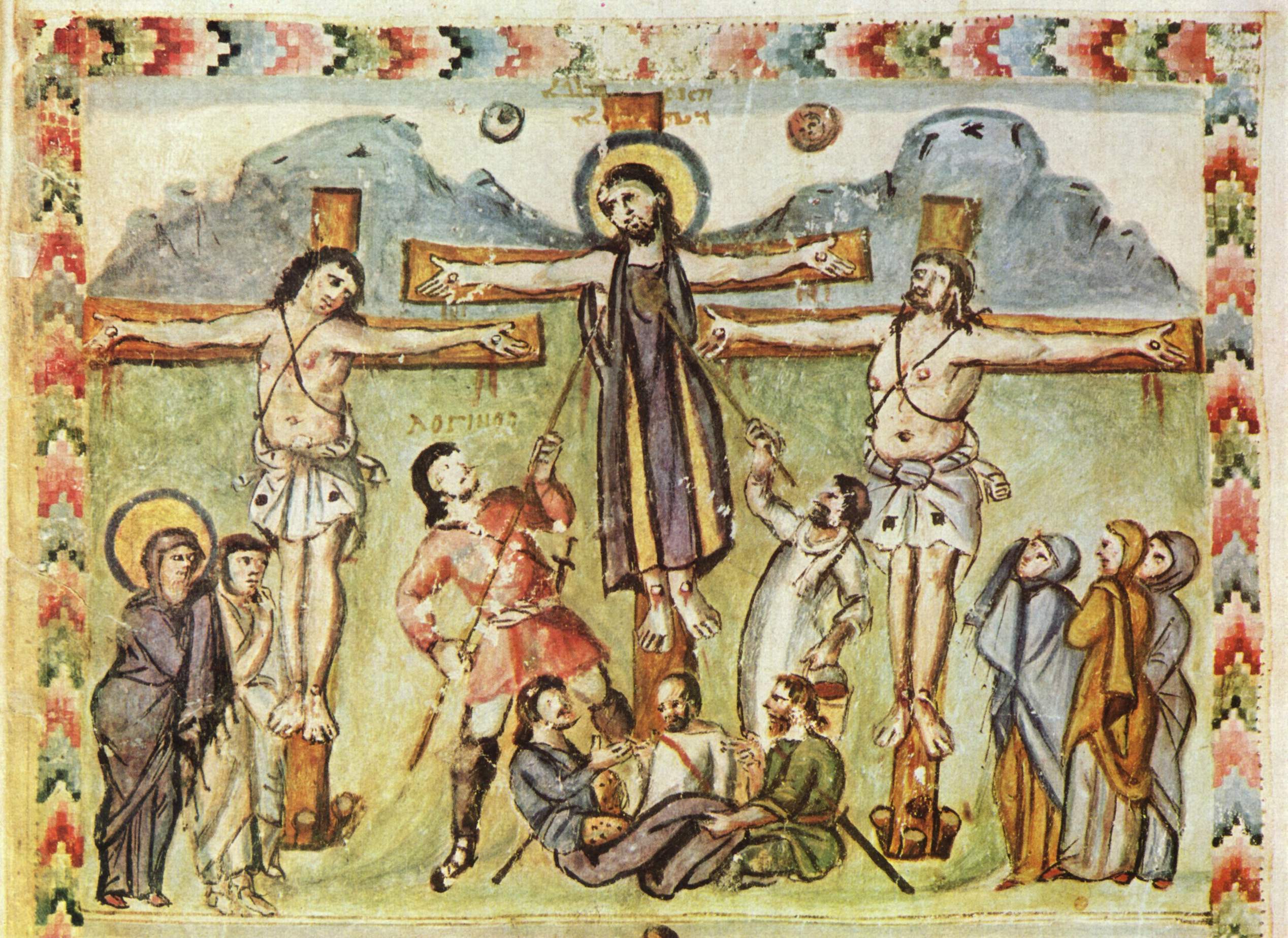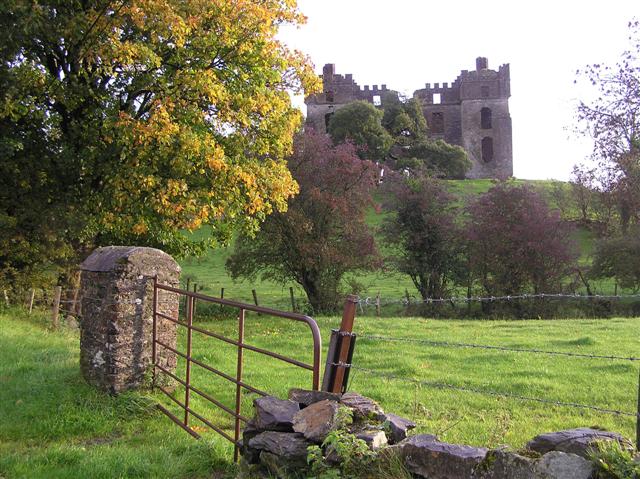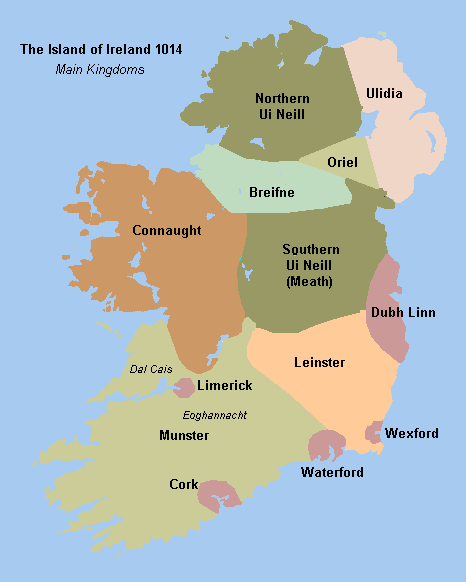|
Maghera Old Church
Maghera Old Church (also known as Old St. Lurach's Church) is the ruins of a church in Maghera, County Londonderry, Northern Ireland. It is a scheduled monument and a Monument in State Care. It was originally founded by St Lurach at some point during the 6th century, likely as a monastery. It is mentioned in the Annals of Ulster when it was plundered by Vikings in 832 and many of its abbots killed. The church later suffered significant damaged when it was burned in 1135. From the mid-12th century until 1245 it was the seat of a bishop, after which it became a parish church. It was damaged due to warfare in 1688, but rebuilt. It was later abandoned in 1819 when the new St. Lurach's Church was built across the road. In 1880, following the disestablishment of the Church of Ireland, it passed into state care. An extensive conservation effort was completed in 1984. In the graveyard, west of the church, is a cross-carved pillar stone, which is traditionally believed to hold the rema ... [...More Info...] [...Related Items...] OR: [Wikipedia] [Google] [Baidu] |
Maghera
Maghera ( ; ) is a small town at the foot of the Glenshane Pass in Northern Ireland. Its population was 4,235 in the 2021 United Kingdom census, 2021 census. Formerly in the Barony (Ireland), barony of Loughinsholin within the historic County Londonderry, it is today in the local-government district of Mid-Ulster District, Mid-Ulster. History One mile north of the town is a single-chamber Megalith, megalithic tomb known as Tirnony dolmen. The portals surrounding the tomb are five feet tall. The town dates back at least to the 6th century to the monastery founded by Saint Lurach whose family were possibly evangelised by Saint Patrick. The ''Annals of Ulster'' say that the seat of the Cenél nEógain, Cenél nEoghain was at Ráth Luraig in Maghera. Standing upon the site of the monastery, the present day ruins of St. Lurach's Church date back to the 10th century (see Maghera Old Church). They include, over a doorway, a relief of the crucifixion, possibly the oldest in Ireland. T ... [...More Info...] [...Related Items...] OR: [Wikipedia] [Google] [Baidu] |
Ulster
Ulster (; or ; or ''Ulster'') is one of the four traditional or historic provinces of Ireland, Irish provinces. It is made up of nine Counties of Ireland, counties: six of these constitute Northern Ireland (a part of the United Kingdom); the remaining three are in the Republic of Ireland. It is the second-largest (after Munster) and second-most populous (after Leinster) of Ireland's four traditional provinces, with Belfast being its biggest city. Unlike the other provinces, Ulster has a high percentage of Protestantism in Ireland, Protestants, making up almost half of its population. English is the main language and Ulster English the main dialect. A minority also speak Irish, and there are (Irish-speaking regions) in County Donegal which is home to a quarter of the total Gaeltacht population of the Republic of Ireland. There are also large Irish-speaking networks in southern County Londonderry and in the Gaeltacht Quarter, Belfast. Ulster Scots dialect, Ulster-Scots is al ... [...More Info...] [...Related Items...] OR: [Wikipedia] [Google] [Baidu] |
Virgin Mary
Mary was a first-century Jewish woman of Nazareth, the wife of Saint Joseph, Joseph and the mother of Jesus. She is an important figure of Christianity, venerated under titles of Mary, mother of Jesus, various titles such as Perpetual virginity of Mary, virgin or Queen of Heaven, queen, many of them mentioned in the Litany of Loreto. The Eastern Orthodox Church, Eastern and Oriental Orthodox, Catholic, Anglican, Methodist, Reformed Christianity, Reformed, Baptist, and Lutheran churches believe that Mary, as mother of Jesus, is the Theotokos, Mother of God. The Church of the East historically regarded her as Christotokos, a term still used in Assyrian Church of the East liturgy. Other Protestant views on Mary vary, with some holding her to have lesser status. She has the Mary in Islam, highest position in Islam among all women and is mentioned numerous times in the Quran, including in a chapter Maryam (surah), named after her.Jestice, Phyllis G. ''Holy people of the world: a cros ... [...More Info...] [...Related Items...] OR: [Wikipedia] [Google] [Baidu] |
Longinus
Longinus (Greek: Λογγίνος) is the name of the Roman soldier who pierced the side of Jesus with a lance, who in apostolic and some modern Christian traditions is described as a convert to Christianity. His name first appeared in the apocryphal Gospel of Nicodemus. The lance is called in Catholic Christianity the "Holy Lance" ('' lancea'') and the story is related in the Gospel of John during the Crucifixion. This act is said to have created the last of the Five Holy Wounds of Christ. This person, unnamed in the Gospels, is further identified in some versions of the story as the centurion present at the Crucifixion, who said that Jesus was the son of God, so he is considered as one of the first Christians and Roman converts. Longinus's legend grew over the years to the point that he was said to have converted to Christianity after the Crucifixion, and he is traditionally venerated as a saint in the Roman Catholic Church, Eastern Orthodox Church, and several other Christi ... [...More Info...] [...Related Items...] OR: [Wikipedia] [Google] [Baidu] |
Stephaton
Stephaton, or Steven, is the name given in medieval Christian traditions to the Roman soldier or bystander, unnamed in the Bible, who offered Jesus a sponge soaked in vinegar wine at the Crucifixion. In later depictions of the Crucifixion, Stephaton is frequently portrayed with Longinus, the soldier who pierced Jesus' side with a spear. It is not to be confused with a Xylospongium, a sponge that is soaked in vinegar attached to a stick the Romans used after defecating. Gospel accounts The account of Jesus receiving a sponge soaked in vinegar while on the cross appears in all four of the canonical gospels, with some variation. In both and , just after Jesus says "My God, my God, why have you forsaken me", a bystander soaks a sponge in vinegar and raises it on a reed for Jesus to drink. mentions that the attendant soldiers offer Jesus vinegar while mocking him – moving the mocking motif that occurs earlier in Mark and Matthew to the Crucifixion.Johnson, Luke Timothy, and Dani ... [...More Info...] [...Related Items...] OR: [Wikipedia] [Google] [Baidu] |
County Meath
County Meath ( ; or simply , ) is a Counties of Ireland, county in the Eastern and Midland Region of Republic of Ireland, Ireland, within the Provinces of Ireland, province of Leinster. It is bordered by County Dublin to the southeast, County Louth, Louth to the northeast, County Kildare, Kildare to the south, Offaly to the southwest, Westmeath to the west, County Cavan, Cavan to the northwest, and County Monaghan, Monaghan to the north. To the east, Meath also borders the Irish Sea along a narrow strip between the rivers River Boyne, Boyne and Delvin River, Delvin, giving it the List of Irish counties by coastline, second shortest coastline of any county. Meath County Council is the Local government in the Republic of Ireland, local authority for the county. Meath is the List of Irish counties by area, 14th-largest of Ireland's 32 traditional counties by land area, and the List of Irish counties by population, 8th-most populous, with a total population of 220,826 according to ... [...More Info...] [...Related Items...] OR: [Wikipedia] [Google] [Baidu] |
Dunshaughlin
Dunshaughlin ( or locally ) is a town in County Meath, Ireland. A commuter town for nearby Dublin, Dunshaughlin more than tripled in population (from 2,139 to 6,644 inhabitants) between the 1996 and 2022 censuses. The town is in a townland and civil parish of the same name. History Foundation Dunshaughlin is named for Saint Seachnall, who established a church there in the 5th century, where he is said to be buried. The oldest reference to the place name is an entry in the '' Annála Uladh'' from the year 801, where the name takes the form "Domnaig Sechnaill". The word "Domnach", used in this way, can be attributed to churches which originate from the beginnings of Christianity in Ireland. North of the ruins of the original church, on the site, there is a Church of Ireland church built in 1814 with funds from the Board of First Fruits. Máel Sechnaill mac Domnaill was an ancestor from which the principal family of Brega, Ó Maoilsheachlainn, is descended. Dunshaughlin (o ... [...More Info...] [...Related Items...] OR: [Wikipedia] [Google] [Baidu] |
County Donegal
County Donegal ( ; ) is a Counties of Ireland, county of the Republic of Ireland. It is in the Provinces of Ireland, province of Ulster and is the northernmost county of Ireland. The county mostly borders Northern Ireland, sharing only a small border with the rest of the Republic. It is named after the town of Donegal (town), Donegal in the south of the county. It has also been known as County Tyrconnell or Tirconaill (), after Tyrconnell, the historical territory on which it was based. Donegal County Council is the local government in the Republic of Ireland, local council and Lifford is the county town. The population was 167,084 at the 2022 census of Ireland, 2022 census. Name County Donegal is named after the town of Donegal (town), Donegal () in the south of the county. It has also been known by the alternative name County Tyrconnell or Tirconaill (, meaning 'Land of Conall Gulban, Conall'). The latter was its official name between 1922 and 1927. This is in reference to th ... [...More Info...] [...Related Items...] OR: [Wikipedia] [Google] [Baidu] |
Raphoe
Raphoe ( ; ) is a small town in County Donegal in the north-west of Ulster, the northern province in Ireland. It is the main town in the fertile district of East Donegal known as the Laggan. It gave its name to the Barony of Raphoe, which was later divided into the baronies of Raphoe North and Raphoe South, as well as to the Roman Catholic Diocese of Raphoe and the Church of Ireland (Anglican) Diocese of Derry and Raphoe. There is also a civil parish of Raphoe.Placenames Database of Ireland (see archival records) The Burn Dale (also known in English as the Burn Deele) is a '''' (a small river) that flows a short dist ... [...More Info...] [...Related Items...] OR: [Wikipedia] [Google] [Baidu] |
Belfry (architecture)
The belfry /ˈbɛlfri/ is a structure enclosing Bell (instrument), bells for ringing as part of a building, usually as part of a bell tower or Steeple (architecture), steeple. It can also refer to the entire tower or building, particularly in continental Europe for such a tower attached to a city hall or other civic building. A belfry encloses the bell chamber, the room in which the bells are housed; its walls are pierced by openings which allow the sound to escape. The openings may be left uncovered but are commonly filled with louvers to prevent rain and snow from entering and damaging the bells. There may be a separate room below the bell chamber to house the ringers. Etymology The word ''belfry'' comes from the Old French, Old North French or , meaning 'movable wooden siege tower'. The Old French word itself is derived from Middle High German , 'protecting shelter' (cf. the cognate ''bergfried''), combining the Proto-Germanic , 'to protect', or , 'mountain, high place', wit ... [...More Info...] [...Related Items...] OR: [Wikipedia] [Google] [Baidu] |
History Of Ireland (1169–1536)
The history of Ireland from 1169–1536 covers the period from the arrival of the Cambro-Normans to the reign of Henry VIII of England, who made himself King of Ireland. After the Norman invasion of 1169–1171, Ireland was under an alternating level of control from Norman lords and the King of England. Previously, Ireland had seen intermittent warfare between provincial kingdoms over the position of High King. This situation was transformed by intervention in these conflicts by Norman mercenaries and later the English crown. After their successful conquest of England, the Normans turned their attention to Ireland. Ireland was made a lordship of the King of England and much of its land was seized by Norman barons. With time, Hiberno-Norman rule shrank to a territory known as the Pale, stretching from Dublin to Dundalk. The Hiberno-Norman lords elsewhere in the country became Gaelicised and integrated in Gaelic society. Arrival of the Normans (1167–1185) By the 12t ... [...More Info...] [...Related Items...] OR: [Wikipedia] [Google] [Baidu] |
Banagher Old Church
Banagher Old Church is a monument in state care, and a scheduled monument, in Banagher near Dungiven in County Londonderry, Northern Ireland. Local tradition ascribes the foundation of the church to either Saint Patrick, or more commonly, St Muiredach O’Heney. Whilst an inscription etched in the 1730s states that ‘this church was built in ye year of God 474’, there is no evidence that the church is that old. Instead it was likely founded towards the end of the 11th century. Its first definitive reference in recorded history is related to 1121, when it is mentioned in the Annals of Ulster as the site where the king of the Ciannachta was killed by his own kinsmen. It was later noted as the base for Archbishop Colton of Armagh's 1397 visit to the Diocese of Derry. It is unknown when the church was abandoned, but a survey of churches of the area in 1622 noted it was already ruined. Interest in the site as an important ecclesiastical ruin was revived in the late 19th century. I ... [...More Info...] [...Related Items...] OR: [Wikipedia] [Google] [Baidu] |







